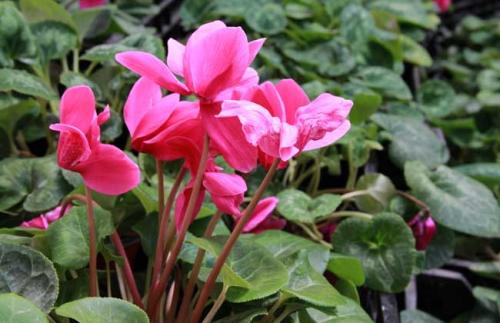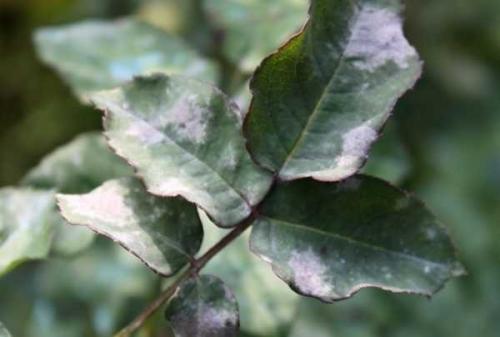What is the reason why cyclamen leaves turn yellow?
What is the cause of cyclamen leaves yellowing? Many kinds of cyclamen flower lovers will encounter this kind of trouble. In fact, in many cases, we are excessive in watering and fertilizing during the breeding process, resulting in the yellow edge of cyclamen leaves. Too much water can easily lead to root decay and yellowing of leaves. Below we summarize in detail the other reasons why cyclamen leaves are yellowing.
The reasons for the yellow leaves of cyclamen are as follows

1. Lose weight for a long time. There is no application of nitrogen fertilizer or no change of water for a long time, and the lack of nitrogen and other nutrient elements in the water leads to thin branches and leaves and thin and yellow leaves. It is necessary to change into new culture water in time and gradually apply rarefied mature liquid fertilizer or compound flower fertilizer.
2. Excessive fertilization. If you fertilize too much, the new leaves will be thick and uneven, and the dry tips of the old leaves will fall off. You should immediately stop fertilization, increase the amount of water exchange, make the fertilizer lose, or immediately pour the pot, rinse the bulb root with water and then plant it back into the basin.
3. Hot and high temperature. If you put the daffodils in high temperature and let the strong light shine directly, it is very easy to cause the leaf tip and edge of young leaves to scorch, or the leaves yellow to fall off. Move to a well-ventilated shady place in time.
4. Excessive shade. If the daffodils are kept in shade or lack of light for a long time, it will cause the branches and leaves to turn yellow.
5. Soil and water is alkaline. Due to the lack of soluble iron and other elements that can be absorbed by the water, the leaves will gradually turn yellow. Acid soil and water should be selected when planting, and alum and fertilizer water should be often watered during the growth period.
6. Whether it is airtight or not. If too much nitrogen fertilizer is applied, the branches and leaves will grow luxuriantly, and the leaves will not be pruned for a long time, resulting in insufficient light in the inner chamber branches and leaves, which is easy to cause leaves to yellowing and falling off. Fertilizer should be applied reasonably and pruning should be strengthened to make it ventilated and transparent.
The air is dry. When the indoor air is too dry, daffodils often appear leaf tip drying or leaf edge scorching and other phenomena. Attention should be paid to water spraying, plastic film cover and other methods to increase air humidity.
Matters needing attention in cyclamen culture
Some people are afraid that cyclamen is short of water, so when watering flowers, they not only water too much water at one time, but also store water in the receiving basin under the flowerpot, which is disadvantageous to the growth of cyclamen. The stagnant water in the water basin will cause cyclamen to rot. At the temperature of 17 ℃ ~ 18 ℃, water cyclamen once every 3 days and wait until the soil is dry before watering. In addition, be careful not to spray water on cyclamen leaves and flowers.
Cyclamen likes light but is afraid of strong light. It is OK to have weak light every day. Don't let it be exposed to the sun at noon. When cyclamen flowers are getting lighter and lighter, it is related to lack of light and insufficient fertilization. In particular, it should be pointed out that most of the cyclamen sold in the flower market use professional fertilizer before they go on the market, and the water is softened, so the flowers cultivated are particularly gorgeous. But after consumers buy it home, it is very difficult to keep it well. It is recommended that flower lovers of cyclamen should be watered with pure water or cold boiled water for a day after buying cyclamen, and fertilize every half a month.
Cyclamen is in the habit of dormant in summer. In June, cyclamen leaves are withered and yellow and fall off. At this time, the flower balls can be taken out of the flowerpot and placed in a plastic bag and refrigerated. Pay attention to the temperature of the refrigerator not lower than 0 ℃. After the Beginning of Autumn, he took out the bulb, picked the old roots and withered leaves, and replanted them in the flowerpot. When the new leaves begin to germinate, the normal water and fertilizer management can be restored gradually.
Time: 2019-04-18 Click:
- Prev

Causes and Solutions of Gardenia Leaves Yellowing
What about yellow gardenia leaves? This is the most frequently asked question about Gardenia cultivation recently. Gardenia is easy to cause yellowing of leaves due to negligence in some links in the cultivation process (such as improper watering, improper fertilization, poor lighting environment, etc.).
- Next

Common diseases and insect pests of rose rose and their control
Many rose rose flower lovers will encounter four common diseases of rose rose flowers, such as black spot, powdery mildew, branch blight and root cancer, and occasionally other diseases such as rust, exposure fungus, anthracnose. Etc., but not as serious as the first four diseases
Related
- Fuxing push coffee new agricultural production and marketing class: lack of small-scale processing plants
- Jujube rice field leisure farm deep ploughing Yilan for five years to create a space for organic food and play
- Nongyu Farm-A trial of organic papaya for brave women with advanced technology
- Four points for attention in the prevention and control of diseases and insect pests of edible fungi
- How to add nutrient solution to Edible Fungi
- Is there any good way to control edible fungus mites?
- Open Inoculation Technology of Edible Fungi
- Is there any clever way to use fertilizer for edible fungus in winter?
- What agents are used to kill the pathogens of edible fungi in the mushroom shed?
- Rapid drying of Edible Fungi

